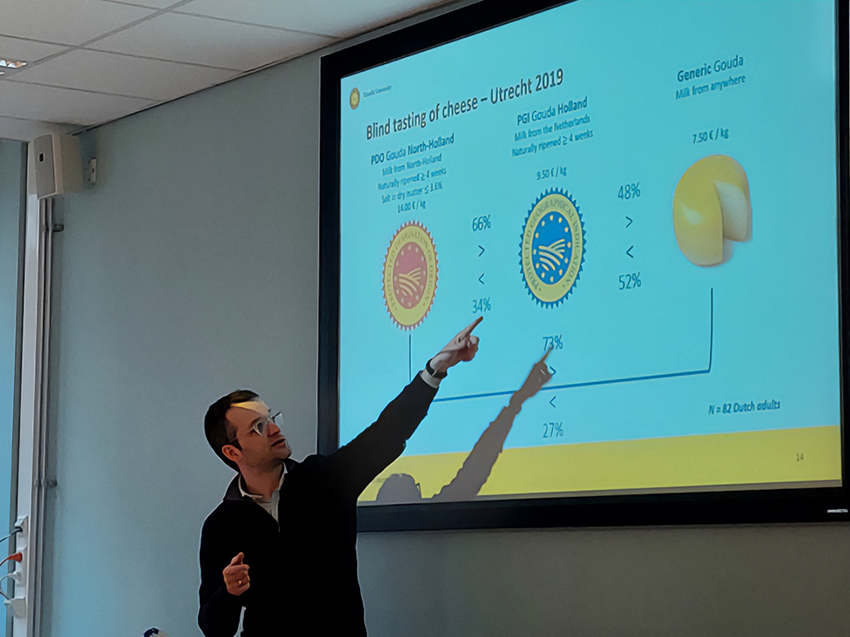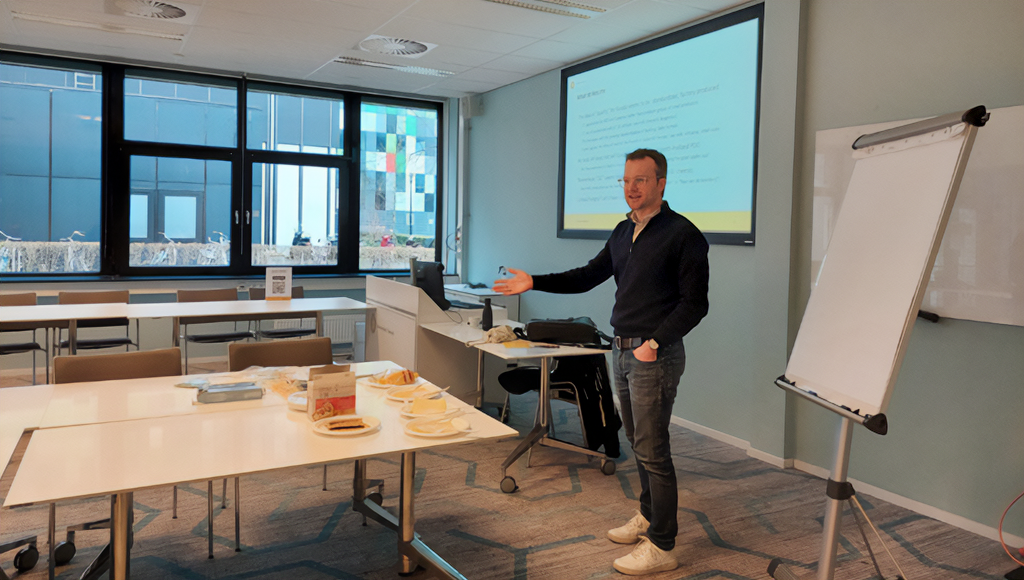Follow the Food’s fourth and final seminar took place on January 22nd bringing us full circle and back to cheese, as Martijn Huysmans (Utrecht School of Economics) presented the case of Gouda to an audience from a diverse array of fields, including social impact, political ecology, geography, and responsible innovation.
Huysmans began by highlighting the strengths and weaknesses of Geographical Indications (GIs), presenting their distribution across the European Union and explaining that the Netherlands is home to a relatively limited number of GIs, which include particular potatoes, asparagus, vlaai and Traditional Specialty Guaranteed (TSG) cheeses.
The speaker showcased the production chain of Dutch Gouda, noting that their fully industrialized processes are an element of pride for producers (a promotional video for Gouda Holland PGI shows large-scale industrial production, a far cry from the traditional representations that are favoured in France and italy). While most European GI cheeses are artisanal and produced with raw-milk, the protected Dutch Gouda cheeses proudly use industrial methods as a display of ensuring food safety and standardization. While most EU consumers assume that “Gouda” cheese has to come from the Netherlands, the word “Gouda” itself is not protected, and the name can be used to describe cheese that follows the Gouda production process regardless of where it is made.
Huysmans’ presentation focused on three particular cheeses: Gouda Holland PGI, Gouda North-Holland PGO and Boerenkaas TSG.
Gouda Holland PGI has been protected since 2010. It has to be made with Dutch milk, must be naturally ripened for at least four weeks, contain 48% to 52% fat and a maximum of 4% salt. Gouda North-Holland PDO has been protected since 1996, the beginning of the EU protection of food GIs. It must be made with milk from North-Holland and therefore cannot be produced in Gouda (which is in South-Holland), the historical cheese market giving its name to the cheese rather than its place of production. Like Gouda PGI, it must be ripened for at least four weeks and contain 48% to 52% fat. However, it cannot contain more than 3.6% salt. In contrast, Boerenkaas is made with raw milk and produced directly within milk production farms. Huysmans warned that consumers should not confuse it with so-called “Boerentrots” or “Kaas van de boerderij”, names which have no legal meaning but are designed to suggest that the products may be of artisanal production.
The discussion that followed the presentation was kicked off by Huysmans sharing an anecdote about not being able to purchase Gouda PGI and Gouda North-Holland PDO in their local Dutch supermarket but easily finding both in a small village store in Brittany, France. This prompted long-time Bassetti Foundation collaborator Cristina Grasseni (Leiden University) to note that the inception of GIs was almost a resistance strategy from southern European countries to hold space for artisanal efforts. Based on Huysmans’ presentation in which he explained that the multinational dairy producer Campina had lobbied for the Gouda North-Holland GI, Grasseni was not surprised that twenty years after their inception, large companies lobby for their own industrial PDOs.
After this engaging conversation, Huysmans proceeded to guide the audience through a blind tasting of four “Jong Belegen” (young mature; ripened for 2 months) cheeses. The participants were easily able to identify the Boerenkaas but had very different opinions on the nature of the three other cheeses, and were very surprised when the cheese types were unveiled!
Are you interested in learning more? Find out more about Europe’s gastronomic heritage, the economics of asymmetric information, and the importance of coming together through the prism of Roquefort and Halloumi in Huysmans’ TEDx talk “Cheese, Love and Understanding”. Missed one of Follow the Food’s events, but curious to learn more about the opportunities and challenges of Geographical Indicators? Find out about GIs and Italian cheese, Tajik apricots, and coffee from Aceh in my other posts in the series.

















